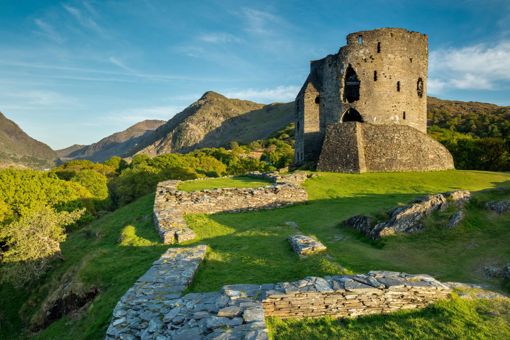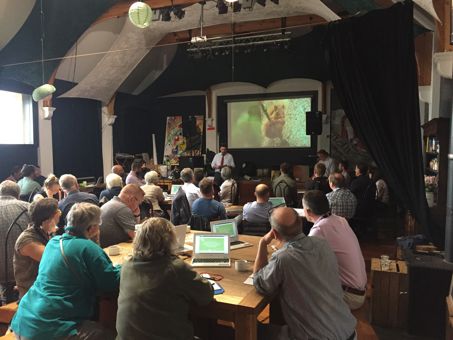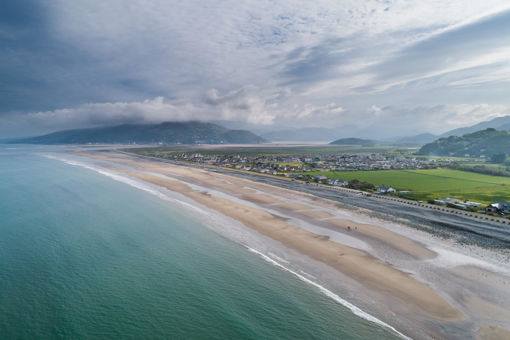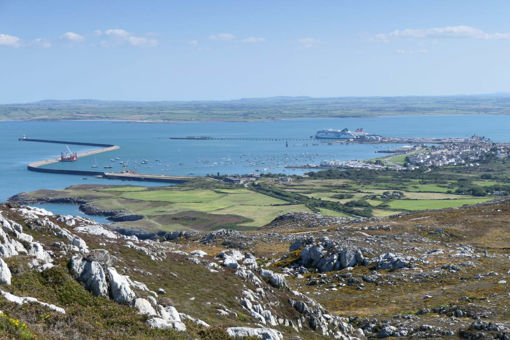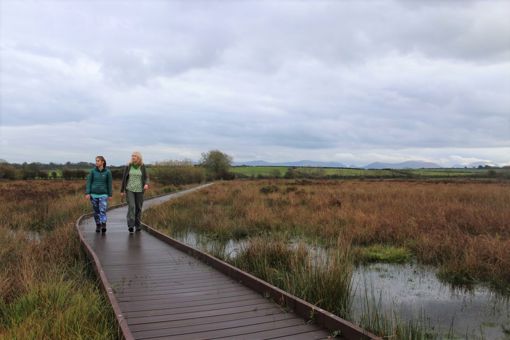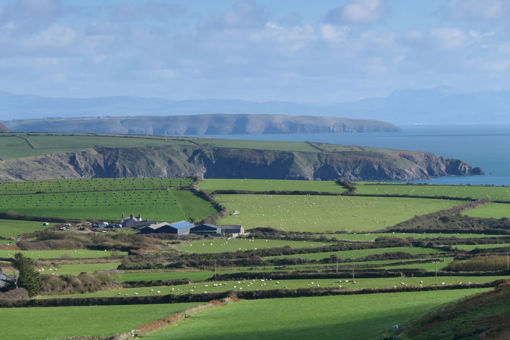Reconnecting people with nature
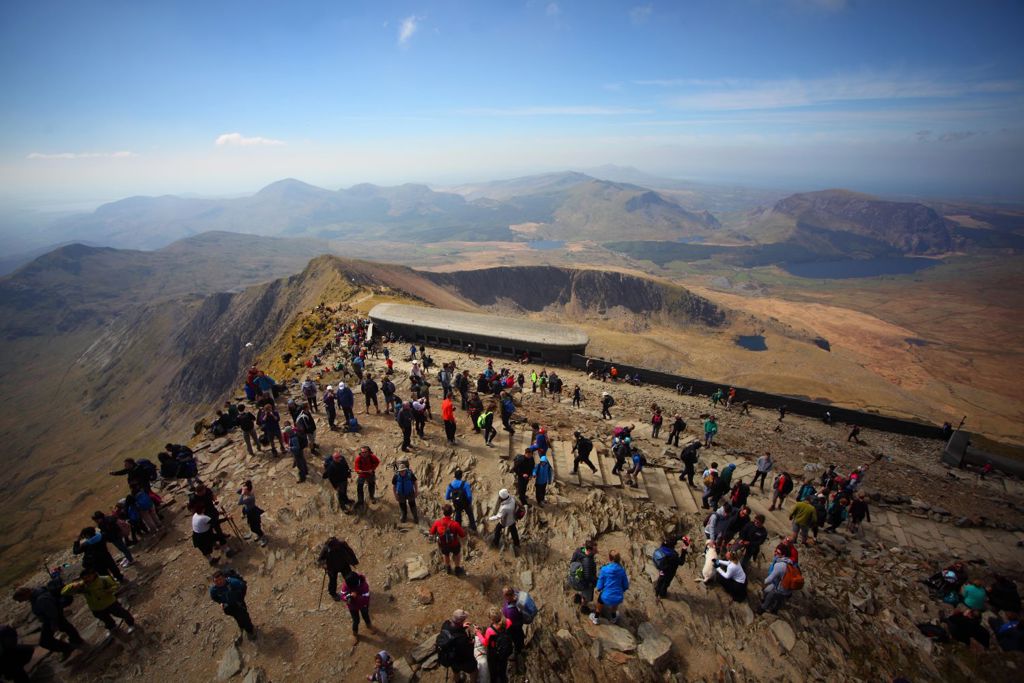
Reconnecting people with nature
This theme challenges us to be more creative and active in the way communities understand, engage, influence their use and value of the local natural environment.
This includes how people can access green and blue spaces, what recreational opportunities exist on both land and water and how people learn about and understand their local and wider environment - and the different activities that take place there, such as farming, growing food and the links between the land, language, culture, and health. It also means that the way development is designed and built should link people to green and blue spaces such as: parks, the coast, rivers, lakes, allotments and the wider countryside. For that to happen, people need the opportunity to access green transport such as cycleways and safe routes. Public spaces should meet the needs of local people of all ages and abilities so that whether they are at work or at home, a connection with nature can help them live a healthier life.
People should have the opportunity to better understand their local environment and the role it plays in their lives, history and culture. Information should be accessible and up to date. Reconnecting with nature means opportunities for being outside in nature and the environment becomes an important and desired part of people’s lives.
Why this theme?
To facilitate the development of the Area Statement, Natural Resources Wales (NRW) held three workshops in North West Wales during July 2019 as well as a session for staff. Based on these discussions it was clear that there is support for an Area Statement theme focusing on reconnecting people with nature. Furthermore, the external audiences were also interested in life-long learning, so that element has been incorporated into this theme. The developed themes were taken back to the stakeholders for validation at our second round of engagement workshops in November and December 2019. More information and detail on this can be found in the Introduction to the Area Statement and in the Ways of Working Theme.

To inform this theme we have considered:
- Local knowledge from a series of structured independently facilitated workshops across North West Wales
- The priorities set in the Natural Resources Policy; Delivering Nature-Based Solutions, Increasing Renewable Energy and Resource Efficiency, Taking a Place-Based Approach
- Information from the State of Natural Resources Report (SoNaRR) on ecosystems and their resilience, and the risks to the benefits they provide
- The well-being assessments and plans, and the priorities that are emerging through Gwynedd and Anglesey and Conwy and Denbighshire Public Service Boards’
External stakeholders highlighted the need to:
- Creatively reconnect people with their local environment to improve physical and mental health, confidence and self-esteem
- Work together to ensure everyone understands the benefit that a healthy environment can bring to society, having joined-up and clear messages about the state of the environment and the benefit it provides
- Work to ensure communities feel a sense of connection and empowerment with their natural environment and have an active role over how it is managed. This also includes community participation and better access to land managed by NRW and other partners
- Work together to create more active travel multi-user routes connecting people with natural resources away from busy roads. Access opportunities need to be built into future development planning
- Ensure we create opportunities for formal and informal education so communities have a better connection to and greater understanding of their local environment
This theme links to the Natural Resource Policy priorities and well-being goals by improving green infrastructure and connecting people to their local natural environment. This will contribute to viable, safe and well-connected communities, consistent with the national goal of ‘A Wales of Cohesive Communities'. It also helps communities become more sustainable and resilient.
Issues identified by stakeholders:
- Access to green and blue space can make a significant contribution to the physical and mental health of the population of North West Wales. Accessible route networks, parks, gardens, beaches and sea fronts and the wider countryside can all play an important role in improving health and well-being. However, these are not always located near to where people live or are not managed in a way that people of all ages and abilities can access them
- There is a need to involve people in planning and developing the right access opportunities to water, urban green spaces and the countryside that meets their needs and contributes to health and social benefits for communities now and in the future
- Reduced resources for managing public rights of way and green spaces can impact on the quality of experience and be a barrier to developing new creative opportunities for people of all key life stages and abilities. By bringing people and organisations together, those who most benefit can have an active role in ensuring future access infrastructure meets their needs
- The need to encourage a sense of citizenship, pride and social values as well as a recognition of the part we all play in better understanding our connection and contribution to the natural environment
Assessment of access opportunities:
Parks, gardens and urban green spaces
Through taking a place based approach and working with the people who live there, we recognise that communities are best placed to shape and understand local priorities, opportunities and find practical solutions that bring the widest benefits. This will ensure that local people benefit fully from natural resources in their locality. Areas with more accessible green space are associated with better mental and physical health. Many of our more deprived communities live close to natural assets from which they are disconnected.
Benefits:
- Cultural services such as recreation and the associated health benefits
- Access to urban green spaces links people to traditional urban park and garden environments and instil an appreciation of local green infrastructure
- Involving people in the design of new green spaces and green transport links as a standard part of the design of new developments will also help to ensure recreation and associated health benefits becomes an integral part of everyday life
Amenity mix species woodland
Appropriately sited woodland creation has many benefits: carbon storage, natural flood risk management, water quality, noise and air pollution mitigation, species diversity, rural skills, jobs, recreation and can help contribute to health and well-being. Engaging people over the design and management of green spaces will ensure they meet the needs of current and future generations and help people reconnect with nature.
Benefit:
- Cultural services such as recreation and associated health benefits
- Involving communities could result in stronger connections with amenity mix species woodland close to where people live and work
- Links with local supply chains so that the public buy more locally produced products. This could include: woodland crafts, firewood and wild foods
- Using woodland as an educational resource for both life long learning and formal education on the biodiversity associated with mixed woodlands. Amenity woodlands can also support the development of skills within communities around the management of local woodlands
-
Woodland therefore also provides provisioning, cultural and supporting services benefits
Rivers and inland water
Improving access opportunities in, to and around inland water bodies such as rivers and lakes where appropriate for recreation and health benefits, including through improving existing public rights of way and where needed new routes.
Benefits:
- Cultural services such as recreation and associated health benefits
- Involving communities in developing recreational opportunities could result in stronger connections with the local water environment close to where they live and work
- Creating new routes in, to and around water bodies such as lakes and rivers could also encourage greater connectivity of habitats and species

Wetlands and bogs
Improving access opportunities to and around wetlands and bog habitats where appropriate. Better understanding of the barriers to access and perceptions about places that are out of reach of local people whether its due to transport, understanding, or value.
Benefits:
- Cultural services such as recreation and associated health benefits
- Access to the beauty of wetlands and bog habitats could also result in a stronger appreciation and connection to these diverse habitats and the benefits they have for natural flood risk, carbon storage and wildlife benefits
- Wetlands and bogs are also a great resource for lifelong learning and formal education around the biodiversity of plants and species and the water cycle
- Creating new links and routes to and around wetlands and bogs could also encourage greater connectivity of habitats and species
Mountains, moors and heaths
Improving access opportunities to upland areas such as mountains, moors, and heaths for all abilities where appropriate. Better understanding of the barriers to access and perceptions about places that are out of reach of local people whether it's due to transport, understanding, or value.
Benefits:
- Cultural services such as recreation and associated health benefits from accessing more wild areas
- Improving existing access for all abilities to mountains, moors and heaths could also result in a stronger appreciation and connection to these diverse habitats and the benefits they provide
- A greater appreciation of the historical features and geomorphology of these areas
Coast and beaches
Linking coastal paths with our communities and other public rights of way networks and increasing active travel/multi-user routes, linking communities to natural resources where appropriate.
Benefits:
- Cultural services such as recreation and associated health benefits from accessing our coastline and beaches
- Linking coastal paths with the wider public rights of way networks will help increase community links with our coastline
Opportunities identified related to this theme:
People value what they understand - by reconnecting people with their local natural environment they will gain a better understanding of the important role their local environment plays in their lives and the influence the environment has had on their history, language and culture. All of the opportunities identified below will only be supported at environmentally appropriate locations.
Overcoming issues together
- Reduced resources for managing public rights of way and green spaces can impact on the quality of experience and be a barrier to developing new creative opportunities for people of all key life stages and abilities. Developing collaborative approaches and innovation by bringing people and organisations together, those who most benefit can have an active role in ensuring future access infrastructure meets their needs.
- Communities are best placed to shape and understand local priorities, opportunities and find practical solutions that bring the widest benefits. Help develop resources within Local Authorities for community engagement and volunteering to support the delivery of ROWIP ( rights of way and promoted routes) and the sustainable management of their own local green spaces.
- Supporting community awareness, support people and communities to help themselves e.g. Awareness of their local environment and available accessible green space and other key issues such as pollution, fly tipping wildlife. Help communities understand and respond to change e.g. Climate Change & flooding.
- Support creative approaches to industry / employment / making a living in the countryside linked to sustainable access and recreation opportunities. Making the connections with others to build sustainable opportunities for businesses, where they consider environmental sustainability and that this is at the heart of their business model.
- Developing a forum for providing and sharing advice, guidance and learning. Working together more cohesively (private, public and charities) to develop innovative and sustainable opportunities for access and recreation.
Access to Blue & Green Spaces (parks, gardens, urban green spaces, amenity woodlands, rivers and inland water, wetlands and bogs, mountains, moors and heaths, coasts and beaches).
- Understanding what opportunities, issues and barriers exist to access both land and water and ensure that people benefit from local quality opportunities now and in the future.
- People have the opportunity to learn about and understand their local and wider environment and the different activities that take place there e.g. Farming, forestry, growing food and the links between land, language & culture.
- Working together to ensure everyone understands the benefit that a healthy environment can bring to society, having joined-up and clear messages about the state of the environment and the benefit it provides. Being outside in nature can creatively reconnect people with their local environment to improve physical and mental health, confidence and self-esteem.
- Social prescribing and volunteering opportunities in the outdoors help connect people to their local natural environment.
- Appropriately sited mixed amenity woodland creation has many benefits (carbon storage, natural flood risk management, water quality, noise and air pollution mitigation, species diversity, rural skills, jobs, recreation and can help contribute to health and well-being). Engaging people over the location, design and management of amenity woodland will ensure they meet the needs of current and future generations and help people reconnect with nature. E.g. incorporated as part of planning mitigation measures as well as being part of potential National Forest / TWIG (The Woodland Investment Grant) initiatives.
- Increased community participation and better access to land managed by NRW and other public and 3rd sector partners.
Educational links
- Ensure we create opportunities for formal and informal education so communities have a better connection to, and greater understanding of, their local environment and the importance of environmental resilience in response to climate change and human pressure.
- Ensuring traditional countryside skills and crafts are maintained- ensuring a range of local engagement opportunities for formal and informal education and lifelong learning.
Communicating with people
- Communication in relation to activities, events and locations where people can engage with nature e.g. through partnership projects and social media.
- Explore collaborative opportunities for communicating and promoting locally and further afield as appropriate.
- Support and promote local supply chains so that the public and all local businesses and organisations source locally produced products.
- Working with digital technology and virtual experiences as innovative ways of connecting people.
Improved Environmental understanding
- Work together to ensure everyone understands the benefit that a healthy environment can bring to society, having joined-up and clear messages about the state of the environment and the benefit it provides.
- Work to ensure communities feel a sense of connection and empowerment with their natural environment and have an active role over how it is managed.
Wellbeing
- Work with Health Boards and landowners to help facilitate opportunities for social prescribing, doctor referrals and volunteering.
- Improve health and well being of patients, staff and communities by increasing access to green space on or near NHS land. E.g. NHS Forest.
Ensuring strategic planning of developments to promote opportunities for sustainable active travel, with links to local green spaces designed into new developments
- New development needs to consider green innovation in its housing design and where appropriate incorporate shared green space, adequate gardens and / or local allotments.
- New development design should also link to green and blue spaces including local parks, the coast, rivers, lakes, allotments and the wider countryside. Involving people in the design of new green spaces and green transport links as a standard part of the design of new developments will also help to ensure recreation and associated health benefits becomes an integral part of everyday life, e.g. walking to school and green commuting.
- Improve opportunities and management (in a way that people of all ages and abilities can access) green transport such as cycleways and safe routes linking people to parks, gardens, schools, public spaces, beaches, sea fronts and the wider countryside.
- Develop a network of multiuser routes connecting communities.
Highlighting successes - Llyn Parc Mawr in Newborough was identified as a recently funded outdoor classroom, built from local wood with a Forest Schools officer employed to engage local schools. Evaluating and exploring the potential to replicate this in other communities should be explored, particularly the emphasis on encouraging intergenerational sharing and learning. The Fens Forever Project was also highlighted as a good example of an opportunity being explored by partners to engage people with understanding the importance of cultural and behavioural change through improved habitat management and access to the Anglesey Fens.
What would success look like?
We will work with the 'Ways of working' and the 'Reconnecting people with nature' themes to develop ways to measure success in collaboration with Local Assess Forums, Forum Eryri and other local partnerships. The opportunities identified below will only be supported in environmentally appropriate locations. Stakeholders have told us that real success should be experienced by communities across the whole area in the following ways:
- Outdoor access and recreation opportunities for all abilities and life stages close to where people live and work offering a range of accessible choices
- Creatively reconnecting people with their local environment to improve their physical and mental health, confidence and self-esteem
- Working in partnership to ensure everyone understands the benefits of a healthy environment to society
- Joined-up and clear messages about the state of the environment and the benefit it provides
- Increased community participation and better access to woodland managed by NRW and others by ensuring communities are more involved in the decision-making so that they deliver well-being benefits for more people
- Communities feel a sense of connection and empowerment and have an active role over how their local environment is managed. For example, mapping out what is already happening in communities, understanding gaps in provision and potential opportunities as well as the identification of community champions who can encourage action
- More native and new mixed woodland cover with public access in the wider environment, on farms, in the rural landscape and around urban areas
- Ensure opportunities to link with the local environment for formal education and lifelong learning, with emphasis on understanding the local environment and how to use and access it safely
- Access to local green spaces, parks and gardens by all ages with the provision of formal or informal seating, water fountains, toilets, disabled parking, and shade
- Development of sustainable recreation and access opportunities to water, such as: fishing, wild swimming and canoeing
- Involving the people that would use and benefit from cycle way improvements and multi-user route development
- Facilities meet the needs of local people of all ages close to where they live and work
- Local authority and partner organisations working to ensure that Area Statements are a part of their planning and development in relation to RDPs and LDPs. Collectively developing approaches to ensure new developments do not negatively impact on active travel routes and that they sustainably provide for, and encourage, improvement to, the development of access opportunities as part of design
- Innovative local interpretation and engagement tools are utilised, which effectively embed the importance and instil greater understanding of the natural environment
- Working in partnership to pool all data, information and case studies in one easily accessible place e.g. NRW’s SMNR portal and opportunities for utilising appropriate citizen science. We collectively want to work out what we need to know to take this theme forward, including identifying collaborative research to answer questions posed
- Further work is needed to collect data and develop a consistent approach to measure progress towards success. This will be developed with our Theme Focus Groups and wider consultation
Benefits
The approach to the North West Area Statement considers the benefits for both wildlife and people of all ages and socio-economic backgrounds. The make-up of the North West area includes economically disadvantaged areas. Improved access to public spaces, wildlife and woodland where appropriate can help boost health, well-being, and improve opportunities for education and work.
Linear access routes can create new verges and wildlife corridor habitats, increasing connectivity for people and wildlife. Creatively engaging people with their local environment will ensure access opportunities meet the needs of those who would benefit from them the most.
Through our engagement, stakeholders have given NRW a good understanding of their priorities to start to develop this theme, but we know this needs to be developed further through focus groups and then tested and expanded with the wider community as we implement our thinking collectively.
Who have we worked with to date?
- Invitations were sent to over 450 people and over the three workshops held, 100 people attended and contributed to the discussions. Natural Resources Wales (NRW) has developed the theme at those events and have been trying different ways to communicate with stakeholders to encourage continued involvement and interest in the local Area Statement
- A second round of workshops were held between November and December 2019 to build on the previous discussions. We have also spoken with partners and listened to their thoughts and feedback, including National Parks Authority meetings, Farming Union meetings and PSB workshops to help develop the content of the themes
- Over 500 invites went out for the second round of workshops in November/December 2019 with over 100 people in attendance
- A series of online workshops were held in November and December 2020 where further discussions were focussed around each theme.
What are the next steps?
We will develop the area wide vision for this theme with stakeholders– with a broad remit and wide representation. We will identify potential partners and interested individuals/groups, gaps in knowledge and linkages with local strategies and action plans, such as Local Development Plans, National Park and AONB Plans, Public Service Board Well-Being Assessments and Rights of Way Improvement Plans.
We will use the information gathered during the stakeholder engagement events (external, internal, with partners such as the National Parks Authority) to guide the activities and influence organisational plans.
For each theme we will need to review what information and data we have so far, plan who we talk to next, look for theories of change, identify barriers and how to overcome and explore opportunities for appropriate action. The Area Statement will be iterative and will change and evolve over time. Groups will be responsible for determining when plans need to change and who needs to be involved in that process.
From this will be able to engage with and enthuse a broader group of stakeholders beyond the wider environmental sector in a targeted way and with a stronger focus on involving and engaging local groups and individuals. This could mean a variety of approaches, including: social media, traditional media, community meetings, drop-in sessions and the strengths of our partners so that we’re all working together to deliver the Area Statement vision and ambitions.

How does what we’ve proposed deliver Sustainable Management of Natural Resources (SMNR)?
Improving mixed native woodland cover close to where people live and work will help reverse the decline in biodiversity and provide woodland habitat connectivity benefits. Woodlands and forests are good for wildlife, they help reduce noise pollution and benefit air quality.
Urban tree planting within new developments and in parks and gardens can be a cost effective way of addressing deteriorating air quality and rising urban temperatures.
Incorporating or embedding access to the countryside in everyday life through encouraging active travel and introducing green spaces into development planning will help reduce car use, congestion and carbon pollution, making our communities safer and more pleasant places to live.
Access to green space can contribute to the physical and mental health of the population of North West Wales. Accessible route networks, parks, gardens and the wider countryside can all play an important role in improving health and well-being. Active Travel and safe routes to schools can help ensure that access to the natural environment becomes a part of everyday life.
How do people get involved?
We welcome opportunities for the public to engage with us at any stage of the Area Statement process. We plan to hold community drop in sessions and workshops during 2020 to help us develop research, look into opportunities and talk to us about your community ideas and consider how they might be funded.
There is also a feedback form and an Email address: northwest.as@cyfoethnaturiolcymru.gov.uk should you wish to write to us with your ideas for developing action under this Theme.
To help as the facilitators of this process, NRW will:
- Work on certain aspects of the conversations that came out of the Area statement stakeholder engagement that identified opportunities and challenges to trial different approaches and develop new ways of working.
Give us your feedback

